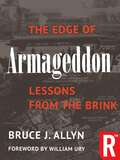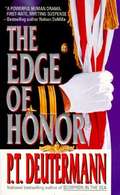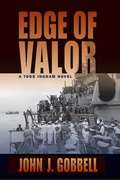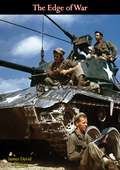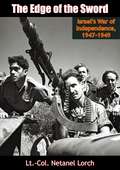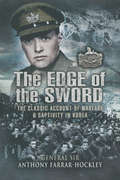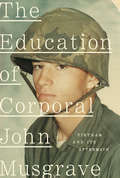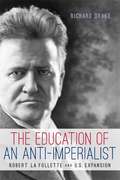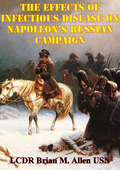- Table View
- List View
The Economics of World War II
by Mark HarrisonThis book provides a new quantitative view of the wartime economic experiences of six great powers; the UK, the USA, Germany, Italy, Japan and the USSR. What contribution did economics made to war preparedness and to winning or losing the war? What was the effect of wartime experiences on postwar fortunes, and did those who won the war lose the peace? A chapter is devoted to each country, reviewing its economic war potential, military-economic policies and performance, war expenditures and development, while the introductory chapter presents a comparative overview. The result of an international collaborative project, the volume aims to provide a text of statistical reference for students and researchers interested in international and comparative economic history, the history of World War II, the history of economic policy, and comparative economic systems. It embodies the latest in economic analysis and historical research.
The Economics of the Wartime Shortage: A History of British Food Supplies in the Napoleonic War and in World Wars I and II
by Mancur Olson JrMancur Olson Jr.’s The Economics of the Wartime Shortage provides a detailed and insightful analysis of how Britain managed its food supplies during three pivotal conflicts: the Napoleonic Wars, World War I, and World War II. Combining economic theory with historical case studies, Olson examines the challenges of maintaining food security in times of crisis and the policies and strategies employed to overcome them.The book delves into the economic mechanisms that drive wartime shortages, from disruptions in international trade and blockades to domestic production constraints. Olson explores how these pressures shaped Britain’s agricultural policies, rationing systems, and government interventions to ensure the population’s survival and morale during periods of prolonged conflict.Through comparative analysis, Olson highlights the similarities and differences in how Britain addressed these crises across three wars. He provides a nuanced view of how technological advancements, shifts in economic thinking, and political leadership influenced the nation’s ability to adapt to extreme circumstances.Rich in historical detail and supported by rigorous economic analysis, The Economics of the Wartime Shortage offers valuable insights into the relationship between economics and policy in times of national emergency. This book is an essential read for historians, economists, and anyone interested in the intersection of war, resource management, and human resilience.
The Edge Chronicles 10: The Immortals
by Chris Riddell Paul StewartThis is the final tale in the Edge Chronicles sequence. Set years in the future, this book is ideal for new readers to discover the series before going back to read the history of Twig, Rook, and Quint.
The Edge of Armageddon
by William Ury Bruce J. Allyn"The Edge of Armageddon shares for the first time the behind-the-scenes stories of how Bruce Allyn worked to bring together former enemies to talk about the past in order to create a more peaceful future. The lessons that my father Nikita Khrushchev learned, and that John F. Kennedy and other veterans of the Cuban Missile Crisis learned, are as relevant today as in 1962." --SERGEI KHRUSHCHEV, Son of former Soviet Premier Nikita Khrushchev, Editor of his father's secret memoirs "Truly captivating, it reads like a page turner, using insiders' history of the Cold War to illuminate how we pulled back from the brink then and how we can deal effectively and peacefully with our differences now." --WILLIAM URY, Co-Author of Getting to Yes, Author of The Third Side and Co-Founder of the Harvard Program on Negotiation Historian Arthur Schlesinger, Jr. called the Cuban Missile crisis, "the most dangerous moment in human history." Bruce Allyn was five years old when it happened but in 1989 would organize and participate in a Moscow meeting with the key living members of the 1962 crisis: Soviet Foreign Minister Andrei Gromyko, the former U.S. Ambassador Anatoly Dobrynin, and Sergei Khrushchev, who had edited the secret memoirs of his father, Soviet Premier Nikita Khrushchev. The United States was represented at the meeting by former U.S. Defense Secretary Bob McNamara, former National Security Advisor McGeorge Bundy and former Kennedy Special Counsel Ted Sorensen. Fidel Castro sent his top Politburo member and a key Army General to the Moscow meeting and he then personally hosted the fascinating final dialogue in Havana. Allyn brings to life through the participants' own words the critical lessons they learned when they stood on the brink of nuclear Armageddon in 1962. The Edge of Armageddon is "you are there" history with the players who made history. Along the way, we learn how the KGB made a serious effort to try to recruit Allyn to spy for the Soviet Union. ABOUT THE AUTHOR Bruce Allyn has for three decades served as a mediator and advisor on political and economic reform in global hotspots in the former Soviet Union, Middle East and Africa. Fluent in Russian from his study of Russian literature in college, Allyn was fortunate to be chosen in 1983 as the bilingual "rapporteur" for a new Harvard-Soviet Joint Study on Crisis Prevention. He would begin dozens of trips to Moscow where he developed close relationships with key Soviet reformers, who later became Mikhail Gorbachev's top advisors and ministers. For the six years Gorbachev was in office, Allyn worked with the Soviet President's inner circle on reform and to convene the historic meetings of the key participants in the 1962 missile crisis. Appointed Director of the Harvard-Soviet Joint Study, Allyn would publish with his colleagues the shocking revelations about how close the world came to nuclear war in the acclaimed Cuba on the Brink: Castro, the Missile Crisis and the Soviet Collapse (Pantheon 1993), which commentators hailed as enlightening and authentic "history by those who made it." Allyn received a Ph.D. in Political Economy and an M.A. in Soviet Studies from Harvard and an M.A. in Philosophy and Politics from Oxford University. His other publications include Windows of Opportunity: From Cold War to Peaceful Competition in U.S.-Soviet Relations (Harper and Row, 1989) and Back to the Brink: Proceedings of the Moscow Conference on the Cuban Missile Crisis (Harvard University, 1992). He is a contributor to the classic college text The Use of Force: Military Power and International Relations (Rowman and Littlefield, 2009).
The Edge of Disaster: Rebuilding a Resilient Nation
by Stephen FlynnAmericans are in denial when it comes to facing up to how vulnerable our nation is to disaster, be it terrorist attack or act of God. We have learned little from the cataclysms of September 11 and Hurricane Katrina. When it comes to catastrophe, America is living on borrowed time-and squandering it. In this new book, leading security expert Stephen Flynn issues a call to action, demanding that we wake up and prepare immediately for a safer future.
The Edge of Honor
by P. T. DeutermannAt the height of the war, Lt. Brian Holcomb is assigned to the USS John Bell Hood, a ship patroling off the coast of Vietnam. Brian is in charge of the ship's computer-driven attack and defense systems. He uncovers a secret drug ring that is ruining the ship and leaving it open to attack. Meanwhile at home, his wife Maddy is fighting her own battles, as a handsome stranger enters her life while her husband is away in Vietnam. A fascinating look at the Navy during Vietnam, Edge of Honor has been one of Deutermann's most popular novels.
The Edge of Tomorrow
by Thomas A. DooleyDr. Dooley and a tiny staff set up two jungle hospitals in Laos, five miles from the edge of the bamboo curtain where they continue to fight disease and communism with antibiotics and understanding. Dooley was a celebrated person during his campaign for health in Indo-china, pre-Vietnam. A very charismatic and political man, he actually was influential bringing this area of the world to the attention of Americans.
The Edge of Valor
by John J. GobbellCommander Todd Ingram, commanding officer of the destroyer, USS Maxwell (DD-525) met Soviet Navy officer Eduard Dezhnev in 1942 when the starshiy leytenant (senior lieutenant) was Naval Attaché to the Soviet Consulate in San Francisco. They became close friends, or so Ingram thought, until he discovered Dezhnev was a spy and had directly contributed to his capture by the Japanese in the Philippines while attempting to rescue his wife to-be, Helen. Later that year, Ingram escaped the Philippines with Helen, and returned to San Francisco, and had Dezhnev expelled from the United States, persona non grata.Ingram had put all that out of his mind, when on the last day of the war, the Maxwell suffers a hit from a Kamikaze attack off Okinawa. She puts into Karama Rhetto, a small archipelago off Okinawa, for repairs. News of the war's end comes the next day and Ingram expects to go home with the others on operation Magic Carpet. Instead, an Army buddy from his days on Corregidor comes after him. He is Brigadier General Otis Dewitt, now intelligence aid on General Douglas MacArthur's staff. In concert with the State Department, DeWitt has temporary orders drawn for Ingram to accompany him to Manila on the same plane as sixteen Japanese senior military and civilian diplomats. Over a swift two days, they negotiate with General MacArthur's staff, the terms for the instrument of surrender, soon to be signed in Tokyo Bay. DeWitt Promises Ingram that he will attend that ceremony.But DeWitt and the State Department have an ulterior motive. After Manila, they send Ingram on to Sakhalin Island to learn what can be done to defuse a Soviet attack on Hokkaido. Why me, asks Ingram? He groans when DeWitt tells him Edward Dezhnev is now a Captain Third Rank in the Soviet Navy. Moreover, Dezhnev is a brigade commander on Sakhalin and is responsible for laying siege to a Japanese holdout in Toro, a natural jumping off place for an attack on Hokkaido.Ingram and Dezhnev were once friends. Maybe it can happen again, Dewitt explains. At the very least, Ingram might be able to gather intelligence on the Soviet's plans to attack Hokkaido. There is something else, DeWitt explains. Walter Boring, a Red Cross representative on the run from Harbin, China, has two crates of overwhelming photographic evidence of Japan's experiments on live human beings; experiments far worse than anything in Nazi Germany. Ingram is expected to return with those crates. But how can he when Boring is being protected by the Japanese garrison in Toro where Dezhnev and his brigade stand ready to overpower them at any moment? Thus Ingram's "friendship" with Dezhnev may be a key factor in securing Boring's release along with his crates. As his shipmates relax and prepare for their return to loved ones, Ingram must go the other way. Three weeks ago he was fighting the Japanese and the Soviets were supposed to be his friends. Now, he doesn't know who to trust.
The Edge of War
by James David Atkinson Adm. Arleigh A. BurkeOriginally published in 1960, in The Edge of War Georgetown University associate professor and author James David Atkinson provides an examination of both the Western and Communist approaches to war. He also covers the evolution of unconventional war, and includes case histories of Guatemala and the stand-up of the Shah of Iran.“It is a privilege to have the opportunity to state my agreement with Dr. Atkinson’s general thesis and especially his observation that ‘warfare of the latter part of the 20th Century is, above all, a battle of the spirit, of ideas, and of the human will.’ This battle will be fought in the hearts, in the minds, and in the souls of men everywhere. It is hoped that this book will serve to awaken many to this fact.”—Adm. Arleigh A. Burke
The Edge of the Blade (The Crusader Knights Cycle)
by Graham ShelbyLove and revenge will drive him across the sea in this epic historical adventure of The Crusader KnightsThe Falkan castle of Tremellion is visited by the mysterious Lord Vaulmier, Treasurer of the Crusade, and his beautiful daughter Christiane de Magnat-Vaulmier. Seeking finance for the Third Crusade against Saladin, they negotiate with Sir Geoffrey Falkan and inveigle all the Falkan fortune, to the fury of Sir Geoffrey’s older son, Ranulf, who will be driven to the most terrible of crimes…Baynard Falkan, younger son and valiant knight errant, sets out on a quest to find Christiane, who has stolen his heart, and to avenge the bloody killing of his father. But to find justice, he must survive bandits and pirates, and travel to the bloody siege of Jerusalem. The Edge of the Blade, the sixth epic historical adventure in The Crusader Knights Cycle, is perfect for fans of David Gilman and Bernard Cornwell. ‘The story is exciting as well as psychologically convincing and thought-provoking’ Financial Times ‘History with a dramatist’s eye for a fine setting and a novelist’s insight into human minds and motives’ Times Literary Supplement
The Edge of the Sword: Errand of Vengeance Book One (Star Trek: The Original Series)
by Kevin RyanA thrilling Star Trek adventure novel featuring Captain Kirk and members of the original crew as they face an unknown phenomenon headed to destroy a planet and its possible origins of a past coming back to haunt them.Lt. Jon Anderson is the newest security officer aboard the U.S.S. Enterprise. He joins the crew at a time of mounting tension between the Federation and the Klingon Empire. Previous battles have been inconclusive, but Starfleet Command fears that the Klingons are gearing up for a major offensive. The Enterprise would be on the front lines of an all-out interstellar war. But Lieutenant Anderson has a secret: he is actually a Klingon infiltrator assigned to sabotage Starfleet from within. His first mission: kill Capt. James T. Kirk.
The Edge of the Sword: Israel’s War of Independence, 1947-1949
by Gen. S. L. A. Marshall Lt.-Col. Netanel LorchFirst published in 1961, this detailed Israeli military history book covering the years 1947-49 book begins with the tensions of the British Mandate period in Palestine, including the international debates over proposed boundaries for the new Jewish state, and examines the chaos that followed the British evacuation, the invasion of five Arab armies supported by guerrilla fighters inside Israel, the defeat of the Arab armies, and the signing of armistice agreements at Rhodes. It surveys the strength, weaknesses, equipment and manpower of Jewish and Arab forces and describes the strategies and tactics used in operations launched by all sides, together with the results of the battles that led to Israel’s pre-1967 borders.“In splendidly crisp, frugal but always fluent narrative, Col. Netanel Lorch relates how Israel won her life with ‘The Edge of the Sword.’ It is an apt title for this masterly deployment of bare facts, devoid of speculative afterthoughts, almost devoid of comment...I rate this book a splendid job of work, absorbing to a student of war, a fit memorial to heroic events passing comprehension.”—The New York Times“...minute in its detail, meticulous in its completeness, matter of fact in its style...but, professional objectivity notwithstanding, he offers a penetrating insight into the passions and purposes that underlay this struggle.”—Herbert Kupferberg, The New York Herald Tribune“Lorch...was fortunate in holding a position in which he was able to obtain and sift much data not normally available to the public. This he has done admirably...It is a timely, comprehensive book...clearly a must for the bookshelf of everyone who takes an interest in military matters or in the Middle East.”—Edgar O’Ballance, The Spectator, LondonRichly illustrated with numerous photos.
The Edge of the Sword: The Classic Account of Warfare & Captivity in Korea
by Anthony Farrar-HockleyAn account of the 1st Battalion, Gloucestershire Regiment, at the Battle of Imjin River during the Korean War and the survivors&’ captivity in a POW camp. In April 1951, at the height of the Korean War, Chinese troops advanced south of the 38th parallel towards a strategic crossing-point of the Imjin River on the invasion route to the South Korean capital of Seoul. The stand of the 1st Battalion, the Gloucestershire Regiment, against the overwhelming numbers of invading troops has since passed into British military history. In The Edge of the Sword General, Sir Anthony Farrar-Hockley, then Adjutant of the Glosters, has painted a vivid and accurate picture of the battle as seen by the officers and soldiers caught up in the middle of it. The book does not, however, end there. Like the majority of those who survived, the author became a prisoner-of-war, and the book continues with a remarkable account of his experiences in and out of Chinese prison camps. This book is not an attempt at a personal hero-story, and it is certainly not a piece of political propaganda. It is, above all, an amazing story of human fortitude and high adventure.
The Education of Corporal John Musgrave: Vietnam and Its Aftermath
by John MusgraveA Marine's searing and intimate story—"A passionate, fascinating, and deeply humane memoir of both war and of the hard work of citizenship and healing in war&’s aftermath. A superb addition to our understanding of the Vietnam War, and of its lessons&” (Phil Klay, author of Redeployment).John Musgrave had a small-town midwestern childhood that embodied the idealized postwar America. Service, patriotism, faith, and civic pride were the values that guided his family and community, and like nearly all the boys he knew, Musgrave grew up looking forward to the day when he could enlist to serve his country as his father had done. There was no question in Musgrave&’s mind: He was going to join the legendary Marine Corps as soon as he was eligible. In February of 1966, at age seventeen, during his senior year in high school, and with the Vietnam War already raging, he walked down to the local recruiting station, signed up, and set off for three years that would permanently reshape his life.In this electrifying memoir, he renders his wartime experience with a powerful intimacy and immediacy: from the rude awakening of boot camp, to daily life in the Vietnam jungle, to a chest injury that very nearly killed him. Musgrave also vividly describes the difficulty of returning home to a society rife with antiwar sentiment, his own survivor's guilt, and the slow realization that he and his fellow veterans had been betrayed by the government they served. And he recounts how, ultimately, he found peace among his fellow veterans working to end the war. Musgrave writes honestly about his struggle to balance his deep love for the Marine Corps against his responsibility as a citizen to protect the very troops asked to protect America at all costs. Fiercely perceptive and candid, The Education of Corporal John Musgrave is one of the most powerful memoirs to emerge from the war.
The Education of Lieutenant Kerrey
by Gregory L. VisticaThe Education of Lieutenant Kerrey is an incredible story and a modern morality tale about a man of compassion and promise trapped by a horrible secret.On the night of February 25, 1969, an inexperienced, 25-year-old lieutenant, Bob Kerrey, led a commando raid on an isolated hamlet called Thanh Phong in Vietnam's Mekong Delta. While witnesses and official records give varying accounts, one thing is certain: around midnight, Kerrey and his men killed nearly two dozen unarmed women and children. What happened that night and why? It's a terrible secret that Kerrey has borne for more than thirty years. Kerrey went on to do heroic things in Vietnam and later as a politician. Since World War II, he is only Medal of Honor winner to sit as a member of Congress. In many ways, Kerrey's life following that tragic mission has been a struggle for redemption.So is Bob Kerrey a war hero or war criminal? Gregory L. Vistica, who uncovered the Thanh Phong atrocities in a widely-praised cover story for The New York Times Magazine, searches the entire span of Kerrey's life to answer that question.. From his rural boyhood in Nebraska, to his gut wrenching Navy SEAL training, to his aborted run for President, Kerrey's life will become a vehicle for understanding the Vietnam generation shaped in the 50s and sharpened by the tumultuous 60s.
The Education of a Navy: The Development of British Naval Strategic Thought 1867-1914
by D. M. Schurman(From the Book jacket) When iron and steam took the place of wood in 1859-60, the Royal Navy so immersed itself in the design of its new ships that the question of how the fleet should be used was almost overlooked. The strategy inherited from the past was considered irrelevant to modern needs. Fortunately, there were some naval men who insisted that the worth of a fleet is not measured solely by the quality of its individual units. Convinced that history had a more useful purpose than the mere recounting of heroic deeds, they showed that the technicians' wholesale dismissal of wooden-wall experience had been far too hasty. The Education of a Navy tells the story of six naval historians who, although not academics by training, took it upon themselves to extract from the archives evidence that the naval past could offer guiding principles for the present. Mr. Schurman ably summarizes the careers and writings of the Colomb brothers-Captain John who was concerned with the Navy's role in national policy, and Admiral Philip whose work made the study of naval history academically respectable; the American Admiral Alfred Thayer Mahan-author of the great Influence of Sea-Power upon History, 1660-1783-who helped make the Royal Navy an instrument of foreign policy; Sir John Laughton, founder of the Navy Records Society; Admiral Sir Herbert Richmond, a formidably able officer who, after retirement, made naval history more acceptable at Cambridge University; and Sir Julian Corbett, a writer with a completely non-military background and the author of the classic Some Principles of Maritime Strategy. About the author: DONALD MACKENZIE SCHURMAN received his doctorate from Cambridge University and is now associate professor of history at the Royal Military College, Kingston, Ontario.
The Education of an Anti-Imperialist
by Richard DrakeRobert M. La Follette (1855-1925), the Republican senator from Wisconsin, is best known as a key architect of American Progressivism and as a fiery advocate for liberal politics in the domestic sphere. But "Fighting Bob" did not immediately come to a progressive stance on foreign affairs. In "The Education of an Anti-Imperialist," Richard Drake follows La Follette's growth as a critic of America's wars and the policies that led to them. He began his political career with conventional Republican views of the era on foreign policy, avidly supporting the Spanish-American and Philippine-American Wars. La Follette's critique of empire emerged in 1910, during the first year of the Mexican Revolution, as he began to perceive a Washington-Wall Street alliance in the United States' dealings with Mexico. La Follette subsequently became Congress's foremost critic of Woodrow Wilson, fiercely opposing United States involvement in World War I. Denounced in the American press as the most dangerous man in the country, he became hated and vilified by many but beloved and admired by others. La Follette believed that financial imperialism and its necessary instrument, militarism, caused modern wars. He contended they were twin evils that would have ruinous consequences for the United States and its citizens in the twentieth century and beyond.
The Effects Of Infectious Disease On Napoleon’s Russian Campaign
by LCDR Brian M. Allen USNThis paper will discuss the effects of infectious disease on Napoleon's forces during the Russian campaign of 1812. In short, it will argue that the primary reason Napoleon failed to defeat the Russian army was because his forces were decimated by disease, specifically typhus, dysentery, and diphtheria. It will also demonstrate the effect of disease and illness on Napoleon's judgement and decision making process. This subject, infectious disease and the military, has great implications for military planners in the future. The recent Gulf war and its related "Gulf War Illness" is just one example. The United States has lost more men to disease during war than any other cause; hence it is critical that today's and tomorrow's military leaders are aware of the dangers. The scope of this paper is bounded by the Russian campaign timeframe, but it will concentrate on the march to Moscow; specifically the events that occurred upon entering Polish and Russian territory. Also, there were two major battles fought prior to reaching the gates of Moscow which this paper will show were the two decisive points in the campaign. These battles occurred at Smolensk and Borodino, and they illustrate key instances where Napoleon's leadership, judgment and decision making come into question, not only by historians and authors, but by several of Napoleon's own generals.The Russians were outnumbered in the summer of 1812 and were forced to play at fight and retreat game with Napoleon's army. This was not well received by the Russian people who were suffering at the hands of the French invaders, but it was just about the only sound course of action the Russians could pursue. The situation turned itself around however when Napoleon reached Moscow and stayed there until an orderly and safe retreat was nearly impossible. At this time the Russian winter was upon them and they had neither the will nor the supplies to return to France.
The Effects Of Logistical Factors On The Union Pursuit Of The Confederate Army: During The Final Phase Of The Gettysburg Campaign
by Colonel Donald J. WetekamFor ten days after the Battle of Gettysburg, the Army of Northern Virginia, under command of Robert E. Lee, remained trapped on the Union side of the flooded Potomac River. During that time, the Army of the Potomac, commanded by George G. Meade, pursued the Confederate forces as they retreated across Pennsylvania and Maryland, attempting but never quite succeeding in bringing about another general engagement. This paper examines the extent to which logistical factors on the Union side of the line hampered the effort to destroy the Confederate army. Specifically, it will seek to show that the resource limitations experienced by the Union army were a decisive factor in their inability to destroy Lee's forces while they remained trapped on Union soil.
The Effects Of Southern Railroads On Interior Lines During The Civil War
by Thomas George Ziek Jr.The purpose of this paper is to study the effects of the Southern railroad system on interior lines during the Civil War and determine whether or not the South enjoyed the advantage of interior lines. The use of railroads during this conflict placed an enormous physical strain upon the limited industrial resources of the Confederacy, and a great strain upon the intellectual agility of the Confederate High Command. Based upon the evidence studied, and the time-space comparisons of both Northern and Southern railway operations, several conclusions can be drawn: the South entered the war with a rail system that was unable to meet the demands of modern war; the Confederate leadership understood the importance of the railroad and its importance to strategic operations early in the war, but were unwilling to adopt a course of action that best utilized their scarce assets; Southern railroad speeds decreased dramatically by 1863 due to the inability of Southern railroads owners to perform needed maintenance on their railroad equipment; tactical reverses on the field of battle, especially the losses of both Corinth in May of 1862 and Knoxville in September of 1863 increased the distances that re-enforcements would have to travel to fight a mobile intra-theater war; Union control, maintenance, and organization of its railway assets ensured that it would be able to move large numbers of troops at the strategic level efficiently from early 1863 to the end of the war. Based on these conclusions, the Confederacy lost the ability to shift troops on the strategic level more rapidly than the Union by 1863. This was a result of its physically weakened railroad system and military setbacks which caused Southern railroads to move forces over longer distances.
The Efficient Kitchen Definite Directions for the Planning, Arranging and Equipping of the Modern Labor-Saving Kitchen: a Practical Book for the Home-Maker
by Georgie Boynton ChildFascinating turn of the 20th century housekeeping bible, richly illustrated.“In this spirit we started on a determined quest for information and new resources. We took lessons in cooking to see whether the Domestic Science schools had any wonderful wisdom to impart in the direction of “better food for less money.” We studied courses in Home Economics. We read books. We visited cooking laboratories and practise houses. Finally we came to the Housekeeping Experiment Station at Darien, Conn.Here at last we found what we had been seeking: an inexpensive but charming home which had been so transformed by engineering skill that it could be cared for with the minimum expense, and so equipped that it could be operated with the smallest possible amount of effort. Here we learned of two wonderful resources for preparing food, adapted to the income of the average home. Here we heard of Taylor’s wonderful book on Scientific Management, which has been revolutionizing the business world. And here we saw two old people living happily an ideal life in which labor and culture each had its rightful place. At last science and high ideals had transformed “villain kitchen vassalage” into the noble profession of home-making.The resources which Mr. and Mrs. Barnard had developed were suited to the needs of two people living simply in the country, free from the demands of city life, and free from all the subtle complications which constantly arise in larger households, particularly in homes where there are little children. But back of their work was a great idea, and this idea was applicable to any home and to any income. “Do not try to do efficient work in an inefficient house. First transform your conditions.” This is one of the first principles of engineering; and, strange as it may seem, the very last principle applied in the average home.”-From the Introduction
The Egg Breakers Counter: Terrorism in Sub Saharan Africa
by Jacobus KotzeTerrorism is never static. It evolves all the time as one side tries to gain the upper hand over the other and in open conflict, where the terrorist makes a stand, he is usually annihilated by the Security Forces, it is never a good tactic unless the terrorism phase becomes a conventional phase.
The Egyptian Intelligence Service: A History of the Mukhabarat, 1910-2009 (Studies in Intelligence)
by Owen L. SirrsThis book analyzes how the Egyptian intelligence community has adapted to shifting national security threats since its inception 100 years ago. Starting in 1910, when the modern Egyptian intelligence system was created to deal with militant nationalists and Islamists, the book shows how the security services were subsequently reorganized, augmented and centralized to meet an increasingly sophisticated array of challenges, including fascism, communism, army unrest, Israel, France, the United Kingdom, conservative Arab states, the Muslim Brotherhood and others. The book argues that studying Egypt’s intelligence community is integral to our understanding of that country’s modern history, regime stability and human rights record. Intelligence studies have been described as the ‘missing dimension’ of international relations. It is clear that intelligence agencies are pivotal to understanding the nature of many Arab regimes and their decision-making processes, and there is no published history of modern Egyptian intelligence in either a European language or in Arabic, though Egypt has the largest and arguably most effective intelligence community in the Arab world. This book will fill a clear gap in the intelligence literature and will be of much interest to students of intelligence studies, Middle Eastern politics, international security and IR in general.
The Eichmann Kommandos [Illustrated Edition]
by Rear-Admiral Michael A. MusmannoIncludes 204 photos, plans and maps illustrating The Holocaust“Fourteen officers of the SS (Elite Guard) were sentenced today to hang for at least a million killings. The sentences wound up the biggest murder trial in history.The men were leaders of the “Einsatz Kommandos”...special extermination squads sent...to do away with peoples classified by the Nazis as racially undesirable.”—NUREMBERG, APRIL 10 (1948)—(ASSOCIATED PRESS)After the first Nuremberg trials of the remaining Nazi leaders in 1945-6, the Allies spent much time and effort in searching out the men responsible for the Holocaust, the full scale of which was only then becoming apparent. In the most important case of his career, Judge Michael A. Musmanno (Captain USN), presided over the trial of the leaders of the Einsatz Kommandos, death squads trained to hunt and kill “Untermenschen” or those deemed undesirable by Hitler. Blazing a bloody trail across the conquered areas of Poland, the Ukraine, White Russia and the Baltic states, the Einsatzgruppen shot innocent men, women and children by the tens of thousands. Finding that shooting was an inefficient way to complete their horrendous executions, the Einsatz Kommando leaders pioneered the use of mobile poison gas trucks which would lead to the evolution of the death camps at Auschwitz-Birkenau, Treblinka, Belzec and Sobibor and the industrialised murder of the Holocaust. In this riveting and horrifying book the author looks back on a trial that serves as a testament to the depths of man’s inhumanity; at times almost surreal in its horror it is a story that should be read and re-read.
The Eichmann Trial and The Rule of Law
by Yosal RogatThe Eichmann Trial and The Rule of Law by Professor Yosal Rogat is one of a series of pamphlets concerning issues that are fundamental to the maintenance of a free society. These pamphlets and related materials were first published in 1961 by the Center for the Study of Democratic Institutions at Santa Barbara, California. The work of the Center was directed at clarifying basic questions of freedom and justice, especially those constitutional questions raised by the emergence of twentieth century institutions. Among the areas that were studied were the economic order, the political process, law, communications, the American character, war as an institution.



